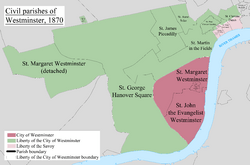Liberty of the Rolls facts for kids
| Liberty of the Rolls | |
 |
|
| Geography | |
| Status | Civil parish |
| 1881 area | 12 acres (0.049 km2) |
| 1901–1921 area | 9 acres (0.036 km2) |
| History | |
| Abolished | 1922 |
| Succeeded by | City of Westminster (parish) |
Quick facts for kids Demography |
|
|---|---|
| 1881 population - 1881 density |
546 45/acre |
| 1901 population - 1901 density |
252 28/acre |
| 1921 population - 1921 density |
93 10/acre |
| Politics | |
| Governance | Master of the Rolls |
The Liberty of the Rolls was a special area in London, England. It was known as a "liberty" and also a "civil parish". Think of it like a small, self-governing neighborhood with its own rules.
This area was probably created a long time ago, during the Middle Ages. It was separated from a larger area called the Farringdon Without Ward in the City of London. The Liberty of the Rolls included part of an old parish called St Dunstan-in-the-West. This part was located in a region of Middlesex called Ossulstone. The rest of the St Dunstan parish was still part of the City of London.
In 1866, the Liberty of the Rolls officially became its own separate civil parish.
What's in a Name?
The Liberty of the Rolls likely got its name from the ancient Rolls House. This important building was located on Chancery Lane. It was where the official records, or "rolls," of the Court of Chancery were kept. The Court of Chancery was a very old court in England that dealt with fairness and justice.
Another idea is that it was named after the Rolls Chapel, a church that was also in the area. Today, the site of the Rolls House and chapel is part of King's College London. It used to be the main office for the Public Record Office, which stored many important historical documents.
Changes Over Time
In 1855, the Liberty of the Rolls became part of the Strand District. This meant it was looked after by the Metropolitan Board of Works. This board was in charge of things like building roads and sewers in London.
The Liberty of the Rolls continued as a civil parish. In 1889, it became part of the new County of London. Then, in 1900, it joined the Metropolitan Borough of Westminster.
The Liberty of the Rolls stopped being a civil parish in 1922. However, its old boundary was still easy to spot. It was the area of Westminster that sat right between the City of London and another area called the Metropolitan Borough of Holborn. Later, Holborn became part of the London Borough of Camden.
This unusual boundary finally changed in 1994. The Local Government Commission for England moved the border. This placed all the land east of Chancery Lane into the City of London.
See also
- Master of the Rolls

